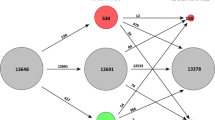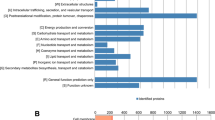Abstract
Some eukaryotes, including bdelloid rotifer species, are able to withstand desiccation by entering a state of suspended animation. In this ametabolic condition, known as anhydrobiosis, they can remain viable for extended periods, perhaps decades, but resume normal activities on rehydration. Anhydrobiosis is thought to require accumulation of the non-reducing disaccharides trehalose (in animals and fungi) or sucrose (in plant seeds and resurrection plants), which may protect proteins and membranes by acting as water replacement molecules and vitrifying agents. However, in clone cultures of bdelloid rotifers Philodina roseola and Adineta vaga, we were unable to detect trehalose or other disaccharides in either control or dehydrating animals, as determined by gas chromatography. Indeed, trehalose synthase genes (tps) were not detected in these rotifer genomes, suggesting that bdelloids might not have the capacity to produce trehalose under any circumstances. This is in sharp contrast to other anhydrobiotic animals such as nematodes and brine shrimp cysts, where trehalose is present during desiccation. Instead, we suggest that adaptations involving proteins might be more important than those involving small biochemicals in rotifer anhydrobiosis: on dehydration, P. roseola upregulates a hydrophilic protein related to the late embryogenesis abundant (LEA) proteins associated with desiccation tolerance in plants. Since LEA-like proteins have also been implicated in the desiccation tolerance of nematodes and micro-organisms, it seems that hydrophilic protein biosynthesis represents a common element of anhydrobiosis across several biological kingdoms.
Similar content being viewed by others
References
D. Bartels F. Salamini (2001) ArticleTitleDesiccation tolerance in the resurrection plant Craterostigma plantagineum. A contribution to the study of drought tolerance at the molecular level Plant Physiology 127 1346–1353 Occurrence Handle10.1104/pp.127.4.1346 Occurrence Handle11743072
J. R. Battista M.-J. Park A. E. McLemore (2001) ArticleTitleInactivation of two homologues of proteins presumed to be involved in the desiccation tolerance of plants sensitizes Deinococcus radiodurans R1 to desiccation Cryobiology 43 133–139 Occurrence Handle11846468
N. Benaroudj D. H. Lee A. L. Goldberg (2001) ArticleTitleTrehalose accumulation during cellular stress protects cells and cellular proteins from damage by oxygen radicals Journal of Biological Chemistry 276 24261–24267 Occurrence Handle10.1074/jbc.M101487200 Occurrence Handle11301331
J. D. Bewley M. Black (1994) Seeds: Physiology of Development and Germination Plenum Press New York
G. Bianchi A. Gamba C. Murelli F. Salamini D. Bartels (1991) ArticleTitleNovel carbohydrate metabolism in the resurrection plant Craterostigma plantagineum Plant Journal 1 355–359
M. A. Blázquez E. Santos C.-L. Flores J. M. Martínez-Zapater J. Salinas C. Gancedo (1998) ArticleTitleIsolation and molecular characterization of the Arabidopsis TPS1 gene, encoding trehalose-6-phosphate synthase Plant Journal 13 685–689 Occurrence Handle9681010
E. A. Bray (1993) ArticleTitleMolecular responses to water deficit Plant Physiology 103 1035–1040 Occurrence Handle12231998
J. A. Browne (2001) An investigation into the physiological and genetic changes associated with anhydrobiosis in the nematodes Panagrolaimus sp. and Aphelenchus avenae National University of Ireland Maynooth
J. Browne A. Tunnacliffe A. Burnell (2002) ArticleTitlePlant desiccation gene found in a nematode Nature 416 38 Occurrence Handle10.1038/416038a Occurrence Handle11882885
T. Chen J. P. Acker A. Eroglu S. Cheley H. Bayley A. Fowler M. L. Toner (2001) ArticleTitleBeneficial effect of intracellular trehalose on the membrane integrity of dried mammalian cells Cryobiology 43 168–181 Occurrence Handle10.1006/cryo.2001.2360 Occurrence Handle11846471
C. Colaço S. Sen M. Thangavelu S. Pinder B. Roser (1992) ArticleTitleExtraordinary stability of enzymes dried in trehalose: simplified molecular biology Bio/Technology 10 1007–1011 Occurrence Handle10.1038/nbt0992-1007 Occurrence Handle1369408
J. H. Crowe L. M. Crowe (1992) Membrane integrity in anhydrobiotic organisms: toward aa mechanism for stabilizing dry cells G. N. Somero C. B. C. L. Osmond Bolis (Eds) Water and Life Springer-Verlag Berlin, Germany 87–103
J. H. Crowe J. F. Carpenter L. M. Crowe (1998) ArticleTitleThe role of vitrification in anhydrobiosis Annual Review of Physiology 60 73–103 Occurrence Handle10.1146/annurev.physiol.60.1.73 Occurrence Handle9558455
J. H. Crowe L. M. Crowe A. E. Oliver N. Tsvetkova W. Wolkers F. Tablin (2001) ArticleTitleThe trehalose myth revisited: introduction to a symposium on stabilization of cells in the dry state Cryobiology 43 89–105 Occurrence Handle10.1006/cryo.2001.2353 Occurrence Handle11846464
A. C. Cuming (1999) LEA proteins P. R. Shewry R. Casey (Eds) Seed Proteins Kluwer Academic Dordrecht, NL 753–780
A. C. Dong S. J. Prestrelski S. D. Allison J. F. Carpenter (1995) ArticleTitleInfrared spectroscopic studies of lyophilization-induced and temperature-induced protein aggregation Journal of Pharmaceutical Sciences 84 415–424 Occurrence Handle7629730
L. Dure SuffixIII (2001) ArticleTitleOccurrence of a repeating 11-mer amino acid sequence motif in diverse organisms Protein and Peptide Letters 8 115–122 Occurrence Handle10.2174/0929866013409643
E. C. A. Eleutherio F. M. Maia M. D. Pereira R. Degre D. Cameron A. D. Panek (1997) ArticleTitleInduction of desiccation tolerance by osmotic treatment in Saccharomyces uvarum var. carlsbergensis Canadian Journal of Microbiology 43 495–498 Occurrence Handle9165704
E. Fuchs D. W. Cleveland (1998) ArticleTitleA structural scaffolding of intermediate filaments in health and disease Science 279 514–519 Occurrence Handle10.1126/science.279.5350.514 Occurrence Handle9438837
G. M. Gadd K. Chalmers R. H. Reed (1987) ArticleTitleThe role of trehalose in dehydration resistance of Saccharomyces cerevisiae FEMS Microbiology Letters 48 249–254 Occurrence Handle10.1016/0378-1097(87)90171-6
A. García Castro Particlede A. Tunnacliffe (2000) ArticleTitleIntracellular trehalose improves osmotolerance but not desiccation tolerance in mammalian cells FEBS Letters 487 199–202 Occurrence Handle10.1016/S0014-5793(00)02340-1 Occurrence Handle11150509
A. García Castro Particlede J. Lapinski A. Tunnacliffe (2000) ArticleTitleAnhydrobiotic engineering Nature Biotechnology 18 473
K. Goyal L. Tisi A. Basran J. Browne A. Burnell J. Zurdo A. Tunnacliffe (2003) ArticleTitleTransition from natively unfolded to folded state induced by desiccation in an anhydrobiotic nematode protein Journal of Biological Chemistry 278 12977–12984 Occurrence Handle10.1074/jbc.M212007200 Occurrence Handle12569097
N. Guo I. Puhlev D. R. Brown J. Mansbridge F. Levine (2000) ArticleTitleTrehalose expression confers desiccation tolerance on human cells Nature Biotechnology 18 168–171 Occurrence Handle10.1038/72616 Occurrence Handle10657122
L. M. Higa C. Z. Womersley (1993) ArticleTitleNew insights into the anhydrobiotic phenomenon – the effects of trehalose content and differential rates of evaporative water-loss on the survival of Aphelenchus avenae Journal of Experimental Zoology 267 120–129 Occurrence Handle10.1002/jez.1402670205
T. Hottiger T. Boller A. Wiemken (1987) ArticleTitleRapid changes of heat and desiccation tolerance correlated with changes in trehalose content in Saccharomyces cerevisiae cells subjected to temperature shifts FEBS Letters 220 113–115 Occurrence Handle10.1016/0014-5793(87)80886-4 Occurrence Handle3301407
D. W Hughes G. A. Galau (1989) ArticleTitleTemporally modular gene expression during cotyledon development Genes and Development 3 358–369 Occurrence Handle2721959
O. Kandror A. DeLeon A. L. Goldberg (2002) ArticleTitleTrehalose synthesis is induced upon exposure of Escherichia coli to cold and is essential for viability at low temperatures Proceedings of the National Academy of Sciences USA 99 9727–9732 Occurrence Handle10.1073/pnas.142314099
Lapinski, J. & A. Tunnacliffe, 2003. Anhydrobiosis without trehalose in bdelloid rotifers. FEBS Letters, in press
P. I. Larsen L. K. Sydnes B. Landfald A. R. Strøm (1987) ArticleTitleOsmoregulation in Escherichia coli by accumulation of organic osmolytes: betaines, glutamic acid, and trehalose Archives of Microbiology 147 1–7 Occurrence Handle10.1007/BF00492896 Occurrence Handle2883950
L. J. M. Linders W. F. Wolkers F. A. Hoekstra K. van’t Riet (1997) ArticleTitleEffect of added carbohydrates on membrane phase behaviour and survival of dried Lactobacillus plantarum Cryobiology 35 31–40 Occurrence Handle10.1006/cryo.1997.2021 Occurrence Handle9302766
K. A. C. Madin J. H. Crowe (1975) ArticleTitleAnhydrobiosis in nematodes: carbohydrate and lipid metabolism during dehydration Journal of Experimental Zoology 193 335–342 Occurrence Handle10.1002/jez.1401930309
M. J. Oliver Z. Tuba B. D. Mishler (2000) ArticleTitleThe evolution of vegetative desiccation tolerance in land plants Plant Ecology 15 85–100 Occurrence Handle10.1023/A:1026550808557
J. J. J. Ooms K. M. Léon-Kloosterziel D. Bartels M. Koornneef C. M. Karssen (1993) ArticleTitleAcquisition of desiccation tolerance and longevity in seeds of Arabidopsis thaliana Plant Physiology 102 1185–1191 Occurrence Handle12231895
R. N. Perry (1999) ArticleTitleDesiccation survival of parasitic nematodes Parasitology 119 S19–S30 Occurrence Handle10.1017/S0031182099004436 Occurrence Handle11254146
C. Ricci (1998) ArticleTitleAnhydrobiotic capabilities of bdelloid rotifers Hydrobiologia 387/388 321–326 Occurrence Handle10.1023/A:1017086425934
J. K. Roberts N. A. DeSimone W. L. Lingle L. III Dure (1993) ArticleTitleCellular concentrations and uniformity of cell-type accumulation of two LEA proteins in cotton embryos Plant Cell 5 769–780 Occurrence Handle10.1105/tpc.5.7.769 Occurrence Handle12271086
M. A. Singer S. Lindquist (1998) ArticleTitleMultiple effects of trehalose on protein folding in vivo and in vitro Molecular Cell 1 639–648 Occurrence Handle10.1016/S1097-2765(00)80064-7 Occurrence Handle9660948
A. Solomon R. Salomon I. Paperna I. Glazer (2000) ArticleTitleDesiccation stress of entomopathogenic nematodes induces the accumulation of a novel heat-stable protein Parasitology 121 409–416 Occurrence Handle10.1017/S0031182099006563 Occurrence Handle11072904
A. Tunnacliffe J. Lapinski (2003) ArticleTitleResurrecting van Leeuwenhoek’s rotifers: a reappraisal of the role of disaccharides in anhydrobiosis Philosophical Transactions of the Royal Society, London B 358 1755–1771
Van Leeuwenhoek, A. Letter to Hendrik van Bleyswijk, dated 9th February 1702. In van Rijnberk, G. & L. C. Palm, 1999 (eds), The collected letters of Antoni van Leeuwenhoek. Vol. 14, 1701–1704. Swets and Zeitlinger, Amsterdam: 55–73
G. Vogel R. A. Aeschbacher J. Müller T. Boller A. Wiemken (1998) ArticleTitleTrehalose-6-phosphate phosphatases from Arabidopsis thaliana: identification by functional complementation of the yeast tps2 mutant Plant Journal 13 673–683 Occurrence Handle10.1046/j.1365-313X.1998.00064.x Occurrence Handle9681009
P. Westh H. Ramløv (1991) ArticleTitleTrehalose accumulation in the tardigrade Adorybiotus coronifer during anhydrobiosis Journal of Experimental Zoology 258 303–311 Occurrence Handle10.1002/jez.1402580305
W. F. Wolkers N. J. Walker F. Tablin J. H. Crowe (2001a) ArticleTitleHuman platelets loaded with trehalose survive freeze-drying Cryobiology 42 79–87 Occurrence Handle10.1006/cryo.2001.2306
W. F. Wolkers S. McReady W. F. Brandt G. G. Lindsey F. A. Hoekstra (2001b) ArticleTitleIsolation and characterization of a D-7 LEA protein from pollen that stabilises glasses in vitro Biochimica Biophysica Acta 1544 196–206
C. Z. Womersley L. M. Higa (1998) ArticleTitleTrehalose: its role in the anhydrobiotic survival of Ditylenchus myceliophagus Nematologica 44 269–291
Author information
Authors and Affiliations
Corresponding author
Rights and permissions
About this article
Cite this article
Tunnacliffe, A., Lapinski, J. & McGee, B. A Putative LEA Protein, but no Trehalose, is Present in Anhydrobiotic Bdelloid Rotifers. Hydrobiologia 546, 315–321 (2005). https://doi.org/10.1007/s10750-005-4239-6
Accepted:
Issue Date:
DOI: https://doi.org/10.1007/s10750-005-4239-6




